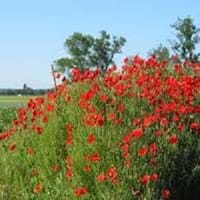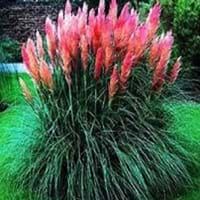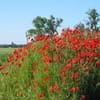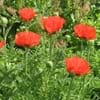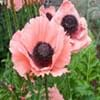Life Span
Perennial
Perennial
Type
Flowering Plants
Grass
Origin
Europe
South America, Argentina
Types
Not Available
Not Available
Habitat
gardens, Grassland, Tropical regions, Urban areas
All sorts of environments
USDA Hardiness Zone
5-8
7-11
Sunset Zone
1a, 1b, 2a, 2b, 3a, 3b, 4, 5, 6, 7, 8, 9, 14, 15, 16, 17
H1, 3a, 3b, 4, 5, 6, 7, 8, 9, 10, 11, 12, 13, 14, 15, 16, 17, 18, 19, 20, 21, 22, 23, 24
Habit
Clump-Forming
Arching/Fountain-shaped
Flower Color
White, Yellow, Red, Orange, Light Yellow, Lemon yellow, Light Pink, Rose, Salmon, Coral, Peach
Pink
Flower Color Modifier
Bicolor
Bicolor
Fruit Color
Not Available
Non Fruiting Plant
Leaf Color in Spring
Gray Green
Green, Gray Green
Leaf Color in Summer
Gray Green
Light Green
Leaf Color in Fall
Gray Green
Green, Gray Green
Leaf Color in Winter
Not Available
Green, Gray Green
Leaf Shape
Bracts
long with sharp edges
Plant Season
Spring, Summer
Spring, Summer, Fall, Winter
Sunlight
Full Sun
Full Sun, Partial Sun, Partial shade
Type of Soil
Loam, Sand
Loam, Sand
The pH of Soil
Acidic, Neutral
Acidic, Neutral, Alkaline
Soil Drainage
Well drained
Well drained
Bloom Time
Late Spring, Early Summer, Summer
Early Summer, Summer, Late Summer, Early Fall
Tolerances
Not Available
Pollution, Salt, Soil Compaction
Where to Plant?
Ground, Pot
Ground
How to Plant?
Seedlings, Transplanting
Divison, Seedlings, Transplanting
Plant Maintenance
Medium
Medium
Watering Requirements
Does not require lot of watering, Water occasionally
Do not water excessively, Keep the ground moist but not water-logged
In Summer
Lots of watering
Lots of watering
In Spring
Moderate
Moderate
In Winter
Average Water
Average Water
Soil pH
Acidic, Neutral
Acidic, Neutral, Alkaline
Soil Type
Loam, Sand
Loam, Sand
Soil Drainage Capacity
Well drained
Well drained
Sun Exposure
Full Sun
Full Sun, Partial Sun, Partial shade
Pruning
Remove damaged leaves, Remove dead branches, Remove dead leaves
Prune before Winter, Remove damaged leaves, Remove dead branches, Remove dead leaves
Fertilizers
All-Purpose Liquid Fertilizer
10-10-10 diluted liquid fertilizer, All-Purpose Liquid Fertilizer
Pests and Diseases
Red blotch
Free of serious pests and diseases
Plant Tolerance
Drought
Drought, moderate salt tolerance
Flower Petal Number
Single
Single
Foliage Texture
Fine
Fine
Foliage Sheen
Matte
Matte
Attracts
Not Available
Birds, songbirds, Wildlife
Allergy
Skin irritation
sneezing
Aesthetic Uses
Showy Purposes
Beautification, Informal Hedge, Mixed Border, Ornamental use, Showy Purposes
Beauty Benefits
Not Available
Not Available
Environmental Uses
Air purification
Air purification
Medicinal Uses
Used as a sedative
No Medicinal Use
Part of Plant Used
Whole plant
Flowering Tips, Stem, Whole plant
Other Uses
Used as Ornamental plant
Showy Purposes
Used As Indoor Plant
Yes
Sometimes
Used As Outdoor Plant
Yes
Yes
Garden Design
Alpine, Container, Cutflower, Mixed Border, Rock Garden / Wall, Wildflower
Dried Flower/Everlasting, Feature Plant, Foundation, Hedges, Screening / Wind Break
Botanical Name
PAPAVER alpinum
CORTADERIA selloana 'Carminea Rendatleri'
Common Name
Alpine Poppy
Pampas Grass, Pink Pampas Grass
In Hindi
अल्पाइन पोस्ता
Pink Pampas grass
In German
Alpine Mohn
Pink Pampas grass
In French
Alpine Poppy
Herbe Pampas rose
In Spanish
Alpine amapola
Hierba de color rosa Pampas
In Greek
Alpine παπαρούνας
Pink Pampas grass
In Portuguese
Alpine Poppy
Grama de Pampas rosa
In Polish
Alpine Poppy
Różowy Pampas trawy
In Latin
Alpini Poppy
Pink Pampas grass
Phylum
Not Available
Tracheobionta
Class
Dicotyledonae
Liliopsida
Order
Ranunculales
Cyperales
Family
Papaveraceae
Poaceae
Clade
Angiosperms, Eudicots
Not Available
Tribe
Not Available
Not Available
Subfamily
Paperveroideae
Not Available
Number of Species
Not Available
Not Available
Season and Care of Alpine Poppy and Pink Pampas Grass
Season and care of Alpine Poppy and Pink Pampas Grass is important to know. While considering everything about Alpine Poppy and Pink Pampas Grass Care, growing season is an essential factor. Alpine Poppy season is Spring and Summer and Pink Pampas Grass season is Spring and Summer. The type of soil for Alpine Poppy is Loam, Sand and for Pink Pampas Grass is Loam, Sand while the PH of soil for Alpine Poppy is Acidic, Neutral and for Pink Pampas Grass is Acidic, Neutral, Alkaline.
Alpine Poppy and Pink Pampas Grass Physical Information
Alpine Poppy and Pink Pampas Grass physical information is very important for comparison. Alpine Poppy height is 10.20 cm and width 10.20 cm whereas Pink Pampas Grass height is 240.00 cm and width 150.00 cm. The color specification of Alpine Poppy and Pink Pampas Grass are as follows:
Alpine Poppy flower color: White, Yellow, Red, Orange, Light Yellow, Lemon yellow, Light Pink, Rose, Salmon, Coral and Peach
Alpine Poppy leaf color: Gray Green
Pink Pampas Grass flower color: Pink
- Pink Pampas Grass leaf color: Green and Gray Green
Care of Alpine Poppy and Pink Pampas Grass
Care of Alpine Poppy and Pink Pampas Grass include pruning, fertilizers, watering etc. Alpine Poppy pruning is done Remove damaged leaves, Remove dead branches and Remove dead leaves and Pink Pampas Grass pruning is done Prune before Winter, Remove damaged leaves, Remove dead branches and Remove dead leaves. In summer Alpine Poppy needs Lots of watering and in winter, it needs Average Water. Whereas, in summer Pink Pampas Grass needs Lots of watering and in winter, it needs Average Water.
